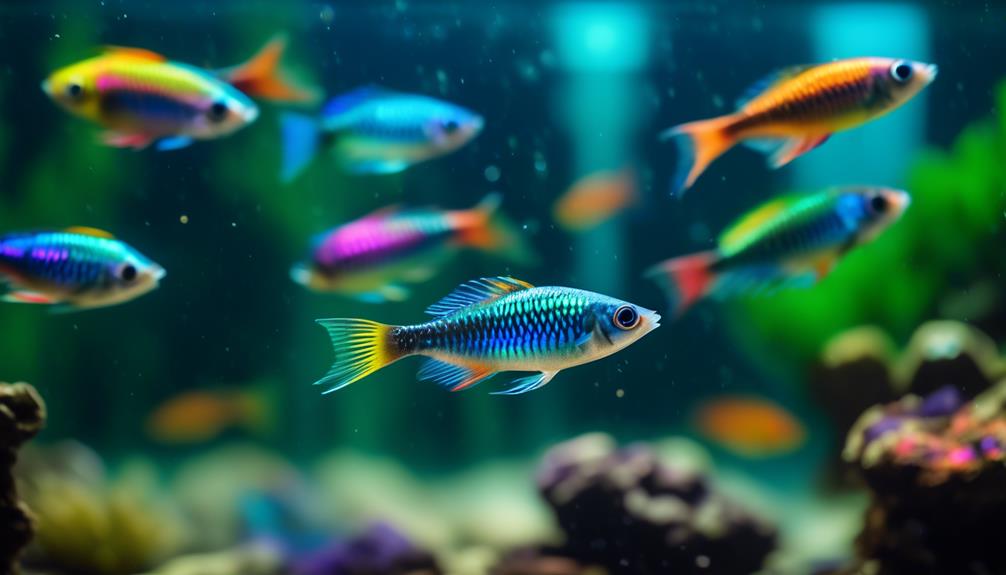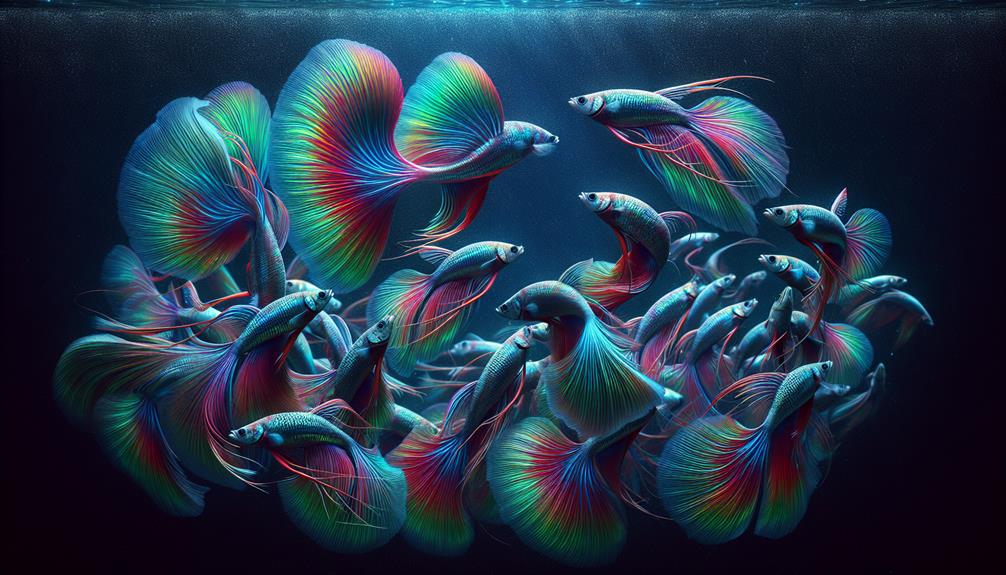The Forktail Rainbowfish, a stunning species native to Papua New Guinea, has long captivated aquarists with its vibrant colors and unique physical features. These fish, scientifically known as Pseudomugil furcatus, possess a remarkable dance that is as mesmerizing as it is intriguing.
As we explore the captivating dance of the Forktail Rainbowfish, we will uncover the secrets behind their graceful movements and the significance of this behavior in their natural habitat.
Get ready to be enthralled by the beauty and elegance of these aquatic dancers, as we unveil the colorful spectacle that awaits in the depths of their world.
Key Takeaways
- Forktail rainbowfish are a small species of rainbowfish found in Papua New Guinea, known for their distinct fork pattern on their tail and glowing blue eyes.
- Females are less colorful than males, but their presence enhances the males' coloration.
- To set up an aquarium for furcata rainbows, provide a 20-gallon or larger tank with live plants, a slightly alkaline pH, and temperatures between 75–80°F.
- Forktail rainbowfish can be kept with peaceful community fish of similar size, but slow-moving fish may be outcompeted during feeding times. Compatibility with betta fish depends on the betta's temperament.
Forktail Rainbowfish: A Vibrant Aquatic Beauty
The Forktail Rainbowfish, Pseudomugil furcatus, is a stunning aquatic species renowned for its vibrant and captivating beauty. This species exhibits unique features and adaptations that contribute to its allure.
One notable feature is the distinct fork pattern on its tail, which gives the fish its name. Additionally, Forktail Rainbowfish possess glowing blue eyes and yellow fins, further adding to their visual appeal.
In terms of behavior and social dynamics, these fish engage in a circular dance while sparring with each other. Males display brighter coloration in the presence of females, making their social interactions even more fascinating to observe.
These unique features and adaptations make the Forktail Rainbowfish an exceptional addition to any aquarium, providing a visually striking and dynamic display for those who desire to serve others.
Setting up the Perfect Aquarium for Furcata Rainbows
With a firm understanding of the captivating beauty and unique features of the Forktail Rainbowfish, it is essential to now explore the meticulous process of setting up an aquarium perfectly suited for the optimal well-being and thriving of the Furcata Rainbows.
When creating a habitat for your furcata rainbowfish, there are two key factors to consider: choosing the right lighting and creating a naturalistic environment.
To ensure the well-being of your furcata rainbowfish, it is important to provide appropriate lighting for their habitat. LED lights are recommended as they provide a full spectrum of light and can be adjusted to mimic natural daylight cycles. This helps to promote the natural behavior and coloration of the fish. Additionally, consider adding floating plants or tall plants that can provide shade and create a visually appealing environment for the fish.
Creating a naturalistic environment is crucial for the overall well-being of furcata rainbowfish. This can be achieved by incorporating live aquarium plants such as Java moss, Anubias, and Amazon sword plants. These plants not only provide hiding places but also help to maintain water quality by absorbing nitrates and providing oxygen. Adding driftwood and rocks can also create natural hiding spots and mimic their natural habitat.
Compatible Tankmates for Forktail Rainbowfish

Living harmoniously with other fish species is an important consideration when selecting tankmates for the Forktail Rainbowfish. To ensure a peaceful coexistence, here are some compatible tankmates for the Forktail Rainbowfish:
- Peaceful community fish of similar size, such as corydoras, tetras, and rasboras, can live together without issues. These fish are known for their calm temperament and will not pose a threat to the Forktail Rainbowfish.
- Slow-moving fish may be outcompeted during mealtimes, so it's important to consider their feeding habits.
Compatibility with betta fish depends on the betta's temperament, as some bettas may display aggression towards other fish. It is recommended to closely monitor their behavior and remove the betta if necessary to maintain harmony in the tank.
In addition to selecting suitable tankmates, incorporating live aquarium plants brings several benefits. These plants provide shelter, hiding spots, and territorial boundaries, reducing aggression and stress among fish. They also enhance water quality by absorbing nitrates and providing oxygen. Overall, the presence of live aquarium plants creates a natural and balanced environment for the Forktail Rainbowfish and its tankmates.
Feeding and Nutritional Needs of Forktail Rainbowfish
Forktail Rainbowfish have specific feeding requirements that must be met to ensure their optimal health and nutritional needs are met. These fish have small mouths and prefer a varied diet consisting of tiny foods. Frozen options such as daphnia, cyclops, and baby brine shrimp are suitable choices. Additionally, Xtreme Nano pellets and Hikari Micro Pellets are recommended.
Including krill flakes and freeze-dried daphnia in their diet can provide additional nutritional value. It is also beneficial to offer live foods like baby brine shrimp and Easy Fry and Small Fish Food. Proper nutrition is of utmost importance for the growth and health of Forktail Rainbowfish.
Breeding Tips and Techniques for Furcata Rainbowfish

Breeding Furcata Rainbowfish requires careful attention to environmental conditions and the provision of appropriate spawning materials. To successfully breed these colorful fish, here are some tips and techniques to consider:
- Breeding Challenges:
- Males can be aggressive towards each other, so it is important to maintain a proper male-to-female ratio to avoid fighting and stress.
- Eggs are small and delicate, making them vulnerable to predation and fungal infections. Providing a separate fry container for hatching can help protect the eggs and increase survival rates.
- Maintaining Water Quality:
- Regular water changes are crucial to ensure optimal water quality and prevent the accumulation of harmful substances.
- Use a high-quality filtration system to maintain stable water parameters, including temperature, pH, and hardness.
- Test water parameters regularly and make necessary adjustments to create the ideal breeding conditions for Furcata Rainbowfish.
Frequently Asked Questions
How Long Do Forktail Rainbowfish Live?
The average lifespan of Forktail Rainbowfish is around 4-5 years in optimal conditions. They are relatively easy to breed if both sexes are present and not too old, making them a popular choice for aquarium enthusiasts.
Do Forktail Rainbowfish Require a Specific Type of Substrate in Their Aquarium?
Forktail rainbowfish do not require a specific type of substrate in their aquarium, but they prefer a sandy or fine gravel substrate. Decorations such as live plants, driftwood, and rocks provide hiding places and create a natural environment. Proper care includes maintaining water parameters, providing suitable tankmates, and offering a varied diet.
Can Forktail Rainbowfish Be Kept in a Community Tank With Aggressive Fish?
Forktail rainbowfish can be kept in a community tank with peaceful tank mates of similar size, such as corydoras, tetras, and rasboras. Aggressive fish may not be suitable companions. The ideal tank setup includes a 20-gallon or larger aquarium with live plants and appropriate water parameters.
Are Forktail Rainbowfish Prone to Any Specific Diseases or Health Issues?
Forktail Rainbowfish are generally hardy, but they can be prone to common aquarium diseases such as ich and fin rot. To prevent health issues, maintain optimal water conditions, provide a balanced diet, and quarantine new fish before introducing them to the tank.
How Often Should Forktail Rainbowfish Be Fed?
Forktail rainbowfish should be fed small, frequent meals throughout the day to mimic their natural feeding behavior. An ideal diet includes a variety of tiny foods such as frozen daphnia, baby brine shrimp, and specially formulated pellets.
Conclusion
In conclusion, the Forktail Rainbowfish, with its vibrant colors and captivating dance, is a fascinating species to observe and care for in an aquarium setting. By providing the appropriate tank setup, suitable tankmates, and a proper diet, enthusiasts can ensure the well-being of these beautiful creatures.
With an interesting statistic to consider, it is worth noting that the Forktail Rainbowfish can display their mesmerizing dance during their sparring rituals for up to several minutes, creating a truly captivating sight for observers.

